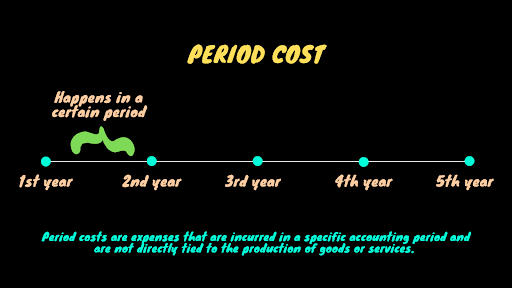What is Period cost?
Period costs are expenses that are incurred in a specific accounting period and are not directly tied to the production of goods or services. These costs are typically classified as selling and administrative expenses and are recorded as expenses in the period in which they are incurred. In contrast, product costs are expenses that are directly related to the production of goods or services and are recorded as assets until the goods or services are sold.
Why period costs are important?
Period costs are an important part of a company's financial statements and play a significant role in the determination of a company's profitability. Understanding the distinction between period costs and product costs is essential for businesses to accurately report their financial performance and make informed decisions about their operations.
Examples of period costs include salaries and wages for non-production employees, rent, utilities, and advertising expenses. These costs are not directly related to the production of goods or services, but rather support the overall operation of the business.
For manufacturing companies, period costs are typically a smaller portion of overall expenses compared to product costs. This is because the majority of a manufacturing company's expenses are directly related to the production of goods, such as the cost of raw materials, labor, and overhead costs.
In contrast, service-based businesses may have a higher proportion of period costs because their expenses are not directly tied to the production of a specific good. For example, a consulting firm may have a higher proportion of period costs due to the costs associated with running an office, hiring and training employees, and marketing services.
Period costs are typically recorded as expenses in the period in which they are incurred, regardless of whether the goods or services have been sold. This means that period costs are not capitalized and are not carried over to future periods.
Benefits of classifying period costs
One of the key benefits of classifying certain expenses as period costs is that it allows a company to better understand the profitability of its operations. By separating period costs from product costs, a company can more accurately determine its gross margin, which is the difference between the cost of goods sold and the revenue generated from the sale of goods or services.
For example, if a company has $100,000 in revenue and $50,000 in product costs, its gross margin would be $50,000. If the company also has $25,000 in period costs, its net income would be $25,000 (gross margin minus period costs). This allows the company to better understand the profitability of its operations and make informed decisions about its expenses.
It's important to note that the distinction between period costs and product costs can be subjective and may vary depending on the specific circumstances of a company. For example, some companies may classify certain expenses as period costs while others may classify the same expenses as product costs. This is why it's important for companies to carefully consider the classification of their expenses and ensure that they are accurately reflected in their financial statements.
Conclusion
In conclusion, period costs are expenses that are incurred in a specific accounting period and are not directly tied to the production of goods or services. These costs are typically classified as selling and administrative expenses and are recorded as expenses in the period in which they are incurred. Understanding the distinction between period costs and product costs is essential for businesses to accurately report their financial performance and make informed decisions about their operations.


